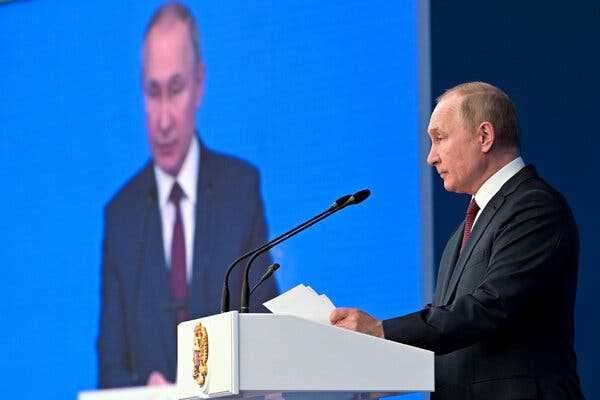The intelligence said the operatives were “trained in urban warfare and in using explosives,” and could try to stage an incident.

President Vladimir V. Putin of Russia in Moscow on Wednesday. The White House did not release details of the evidence it had collected to back up its charge against Russia.
WASHINGTON — The Biden administration accused Moscow on Friday of sending saboteurs into eastern Ukraine to stage an incident that could provide President Vladimir V. Putin of Russia with a pretext for ordering an invasion of parts or all of the country.
The White House did not release details of the evidence it had collected to back up its charge, though one official said it was a mix of intercepted communications and observations of the movements of people. In an email, a U.S. official wrote that “Russia is laying the groundwork to have the option of fabricating a pretext for invasion, including through sabotage activities and information operations, by accusing Ukraine of preparing an imminent attack against Russian forces in eastern Ukraine.”
John F. Kirby, the Pentagon spokesman, called the intelligence about the operation “very credible” when asked about it at a Pentagon briefing on Friday.
The U.S. official who described the intelligence, who spoke on the condition of anonymity, added that the assessment found that “the Russian military plans to begin these activities several weeks before a military invasion, which could begin between mid-January and mid-February. We saw this playbook in 2014 with Crimea.” Russia annexed the Crimean Peninsula, a part of Ukraine, that year. It also sent military forces, who operated without wearing uniforms, into the Donbass region of eastern Ukraine, where the war has been grinding on.
The accusation came a day after the conclusion of a week of diplomatic encounters with Russia, moving from Geneva to Brussels to Vienna, in an effort to de-escalate the confrontation. But those talks ended without any agreement to pull back the approximately 100,000 Russian troops massed on the Ukrainian border, and without U.S. or NATO agreement to demands from Moscow that it pull back all forces from former Warsaw Pact countries that have joined NATO.
The release was clearly part of a strategy to try to prevent the attacks by exposing them in advance. But without releasing the underlying intelligence — some of which has been provided to allies and shown to key members of Congress — the United States opens itself up to Russian charges that it is fabricating evidence. In past years, Russia frequently recalled the deeply flawed intelligence case the United States built for invading Iraq, as part of an effort to discredit the C.I.A. and other American intelligence agencies as political operatives.
The official said that the United States had “information that indicates Russia has already pre-positioned a group of operatives to conduct a false-flag operation in eastern Ukraine,” where Russian-backed forces have been fighting a grinding war of attrition with the Ukrainian government. The operatives “are trained in urban warfare and in using explosives to carry out acts of sabotage against Russia’s own proxy forces.”
Two other American officials said the U.S. assessment was the result of a combination of intercepts and movements on the ground of particular individuals. That could explain the administration’s reluctance to declassify granular information, for fear of alerting the Russian operatives whose movements are being tracked.
“This is a page out of the Russian playbook,” one of the officials said. “We’re very mindful that Russia will try to invent some pretext to carry out a coup attempt.”
One senior administration official said there was concern that saboteurs or provocateurs could stage an incident in Kyiv, the Ukrainian capital, prompting a possible pretext for a coup. President Volodymyr Zelensky of Ukraine declared several months ago that he believed a coup attempt was underway, but it never materialized.
Understand the Escalating Tensions Over Ukraine
Card 1 of 5
A brewing conflict. Antagonism between Ukraine and Russia has been simmering since 2014, when the Russian military crossed into Ukrainian territory, annexing Crimea and whipping up a rebellion in the east. A tenuous cease-fire was reached in 2015, but peace has been elusive.
A spike in hostilities. Russia has recently been building up forces near its border with Ukraine, and the Kremlin’s rhetoric toward its neighbor has hardened. Concern grew in late October, when Ukraine used an armed drone to attack a howitzer operated by Russian-backed separatists.
Ominous warnings. Russia called the strike a destabilizing act that violated the cease-fire agreement, raising fears of a new intervention in Ukraine that could draw the United States and Europe into a new phase of the conflict.
The Kremlin’s position. President Vladimir V. Putin of Russia, who has increasingly portrayed NATO’s eastward expansion as an existential threat to his country, said that Moscow’s military buildup was a response to Ukraine’s deepening partnership with the alliance.
Rising tension. Western countries have tried to maintain a dialogue with Moscow. But administration officials recently warned that the U.S. could throw its weight behind a Ukrainian insurgency should Russia invade.
The U.S. accusation also embraced disinformation operations, charging that in the media “Russian influence actors are already starting to fabricate Ukrainian provocations in state and social media to justify a Russian intervention and sow divisions in Ukraine.” Those include, the official said, “emphasizing narratives about the deterioration of human rights in Ukraine and the increased militancy of Ukrainian leaders.”
In his briefing, Mr. Kirby said that when “we talk about Russian operatives, it could represent a blend of individuals inside the Russian government, whether it’s from their intelligence communities, their security services or even their military.”
He said that the Russians frequently worked in ways where it was “not necessarily really clear who they specifically report to in the conduct of some of these more covert and clandestine operations.”
Source: nytimes.com



